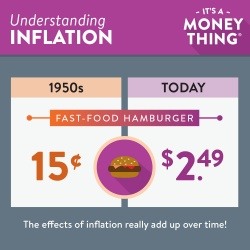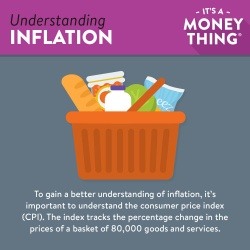
When most people think of inflation, their response is usually similar to when they see a vintage advertisement: reminiscing about the cheaper prices of the past (15 cents for a burger? Awesome!) while simultaneously feeling some resentment towards today’s ever-rising prices. Generally, inflation is seen as a frustrating “financial fact of life” that passively affects everyone as price levels climb and as the dollar’s purchasing power decreases over time.
 The reality is that inflation is affecting your finances more aggressively than you might realize—especially when it comes to your savings. Without the proper planning in place, the effects of inflation could actually be costing you your savings.
The reality is that inflation is affecting your finances more aggressively than you might realize—especially when it comes to your savings. Without the proper planning in place, the effects of inflation could actually be costing you your savings.
How can you lose money by saving it?
We all know that saving money is an important part of any financial plan. Our savings fund our biggest goals, finance our future lifestyle and protect us from life’s curveballs. Unfortunately, simply saving is rarely enough to counter the effects of inflation.
As an example, let’s say that you know you’ll be buying a new pair of eyeglasses sometime in the next 10 years. The type of frames you like and the lenses you need would cost about $400 today, so you decide to do your future self a favor. You stash the cash under your mattress (or some equally obscure hiding place), knowing that you’ll retrieve it when the time comes to purchase a brand-new pair of specs. Then you congratulate yourself for doing the right thing by putting that money aside instead of spending it all. Solid plan, right? Except for one problem: inflation.
In this example, $400 is your savings goal based on the price of eyeglasses today. But following inflation rate patterns, a similar set of frames may cost $485 10 years down the road. Because inflation decreases purchasing power over time, the same amount of cash (in this case, $400) will buy less in the future than it does today. You will not have saved enough to meet your goal.
 Now, let’s say that, instead of stashing the cash under your mattress, you park it in a savings account for that 10 years. You know that it’s a more responsible way to save—if you’re not going to be spending that $400 for a while, you might as well be earning interest on it! At a rate of 1.05%, over 10 years, your initial $400 would grow to $444. You’ll have grown your savings, and while that’s a positive thing, you’d still be $41 short of getting your new glasses.
Now, let’s say that, instead of stashing the cash under your mattress, you park it in a savings account for that 10 years. You know that it’s a more responsible way to save—if you’re not going to be spending that $400 for a while, you might as well be earning interest on it! At a rate of 1.05%, over 10 years, your initial $400 would grow to $444. You’ll have grown your savings, and while that’s a positive thing, you’d still be $41 short of getting your new glasses.
This example makes inflation seem like a minor inconvenience or annoyance—but now imagine scaling this concept up to a giant savings goal like funding your retirement. In setting your goal, you may determine that you need to save up $10,000 a year to maintain the post-career lifestyle you want. But what if by the time you retire, factoring in the effects of inflation, that exact same lifestyle costs double or even triple that amount? What are you to do?
Beat inflation with these strategies
 Inflation can make the act of saving seem like a depressing option, even though savings is a major contributor to your financial well-being. The first step in countering inflation is to acknowledge that it exists, that it is affecting your finances in a very real way and that some extra effort is required to overcome it. The following suggestions will help strengthen your savings against the eroding effects of inflation.
Inflation can make the act of saving seem like a depressing option, even though savings is a major contributor to your financial well-being. The first step in countering inflation is to acknowledge that it exists, that it is affecting your finances in a very real way and that some extra effort is required to overcome it. The following suggestions will help strengthen your savings against the eroding effects of inflation.
1. Plan accordingly
Even though inflation doesn’t affect all products and services equally (for example, in any given year, college tuition rates may rise more steeply than airline ticket rates), it’s almost certain that, in general, the same things will cost more in the future than they do today. Adjust your savings goals and err on the generous side in order to reflect that change.
2. Review your savings rates
When you first started a savings account, you may not have been paying too much attention to what the best interest rates were at the time. Take a look at your savings and see if there’s any opportunity to consolidate your savings into an account with a higher return. (Note: Although the minimal rates on savings account products are usually not enough to counter inflation on their own, taking the time to re-evaluate your savings products is a good practice that can often save you money.)
3. Invest your savings
Inflation is one of the biggest motivating forces for investing your savings. The ultimate goal is to find a rate of return that is higher than the corresponding rate of inflation (and the taxes you’ll owe on that investment income) over that same period of time. Stocks, bonds, mutual funds and treasury securities are all potential investment vehicles for your savings. Keep in mind that every form of investing presents its own set of risks, so the method you choose needs to be in line with your goals and your timeline. Your credit union can be an excellent resource when it comes to seeking investment product information or advice.
In conclusion, the concept of inflation does a lot more harm than just making us gripe about the rising cost of goods and services—it makes it difficult for us to anticipate just how much we need to save in order to reach our financial goals. Increasing the rate of return on your savings through investing is the best way to counter the effects of inflation, and it will help ensure that the money you save today will have the purchasing power to afford what you need in the future.

Was this information useful? Visit our It's A Money Thing home page for more quick videos and helpful articles to help you make sense of your money, one topic at a time! Check back, new topics will be introduced regularly.






 The reality is that inflation is affecting your finances more aggressively than you might realize—especially when it comes to your savings. Without the proper planning in place, the effects of inflation could actually be costing you your savings.
The reality is that inflation is affecting your finances more aggressively than you might realize—especially when it comes to your savings. Without the proper planning in place, the effects of inflation could actually be costing you your savings. Now, let’s say that, instead of stashing the cash under your mattress, you park it in a savings account for that 10 years. You know that it’s a more responsible way to save—if you’re not going to be spending that $400 for a while, you might as well be earning interest on it! At a rate of 1.05%, over 10 years, your initial $400 would grow to $444. You’ll have grown your savings, and while that’s a positive thing, you’d still be $41 short of getting your new glasses.
Now, let’s say that, instead of stashing the cash under your mattress, you park it in a savings account for that 10 years. You know that it’s a more responsible way to save—if you’re not going to be spending that $400 for a while, you might as well be earning interest on it! At a rate of 1.05%, over 10 years, your initial $400 would grow to $444. You’ll have grown your savings, and while that’s a positive thing, you’d still be $41 short of getting your new glasses. Inflation can make the act of saving seem like a depressing option, even though savings is a major contributor to your financial well-being. The first step in countering inflation is to acknowledge that it exists, that it is affecting your finances in a very real way and that some extra effort is required to overcome it. The following suggestions will help strengthen your savings against the eroding effects of inflation.
Inflation can make the act of saving seem like a depressing option, even though savings is a major contributor to your financial well-being. The first step in countering inflation is to acknowledge that it exists, that it is affecting your finances in a very real way and that some extra effort is required to overcome it. The following suggestions will help strengthen your savings against the eroding effects of inflation.


